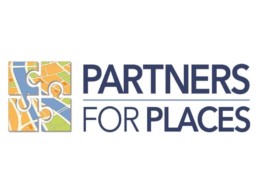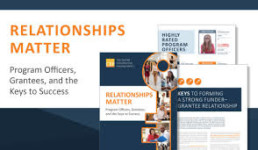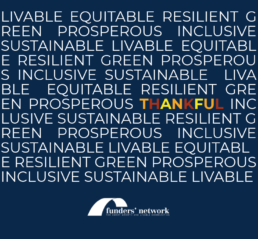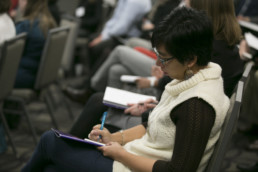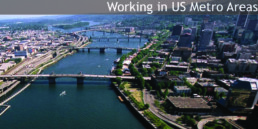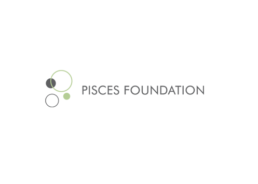TFN 2018 Annual Conference | A message from our Houston co-chairs
We are thrilled to announce that registration is now open for the 2018 Annual Conference of the Funders’ Network for Smart Growth and Livable Communities (TFN), which takes place March 19-21 in Houston.
TFN’s annual conferences provide an exciting opportunity to join funders from across North America to explore the strategies and stories that are creating more equitable, sustainable and resilient places to live.
The conference’s lineup of sessions and speakers will let us hear from diverse and thought-provoking voices on issues such as protecting our natural resources, building inclusive economies and incorporating equitable practices into our work.
We are so proud that TFN’s 2018 Annual Conference will take place in our beloved city of Houston, which continues to rebuild and recover following Hurricane Harvey.
This year’s devastating hurricane season — which affected many communities in the Gulf Coast and South Florida, as well as Puerto Rico and islands across the Caribbean — along with recent earthquakes and fires underline the urgency to address the critical issue of climate change and to build stronger and more resilient communities that can withstand and recover from extreme weather events. It also reinforces the need to approach preparation, relief and recovery in a way that is fair and just, especially for the most vulnerable. Houston is an ideal place for these types of conversations, and we look forward to hearing and sharing our respective experiences, insights and lessons learned to help create more resilient communities.
Beyond discussions of resilience, TFN’s 2018 Annual Conference will connect you to other leaders in philanthropy as well as local leaders and key partners to explore a range of issues associated with environmental sustainability, social equity and economic prosperity. The three-day program also features mobile workshops that will give you a first-hand look at Houston’s vibrant neighborhoods and unique approaches to tackling complex challenges, an Eat Here! reception that highlights the best of our local cuisine, and so much more!
We hope you’ll join us to learn, share, and be inspired. For more information, be sure to visit the TFN 2018 Annual Conference webpage.
We look forward to seeing you in Houston!
Sincerely,
TFN 2018 Annual Conference Co-Chairs
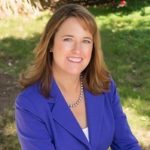 Marilu Hastings
Marilu Hastings
Vice President, Sustainability Programs
The Cynthia & George Mitchell Foundation
 Elizabeth Love
Elizabeth Love
Senior Program Officer
Houston Endowment
Partners for Places: New RFP for sustainable projects released!
The Partners for Places matching grants program, which pairs city governments with philanthropy to support sustainability efforts, has released its latest RFP for sustainability projects that promote a healthy environment, a strong economy, and well-being for all residents.
In partnership with the Urban Sustainability Directors Network, the Funders' Network for Smart Growth and Livable Communities today announced the opening of Round 12 of the Partners for Places grant program.
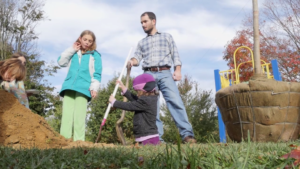
Partners for Places is a successful matching grant program that creates opportunities for cities and counties in the United States and Canada to improve communities by building partnerships between local government sustainability offices and place-based foundations. National funders invest in local projects to promote a healthy environment, a strong economy, and well-being of all residents. Through these projects, Partners for Places fosters long-term relationships that make our urban areas more prosperous, livable, and vibrant. The grant program provides partnership investments between $25,000 and $75,000 for one year projects, or $50,000 and $150,000 for two year projects, with a 1:1 match required by one or more local foundations.
Proposals are due Jan. 29, 2018!
Want to learn more about submitting a successful proposal? Be sure to review our guidance documents and other resources:
Partners for Places now accepts proposals for the creation of a community-focused Sustainability, Climate Action, Adaptation/Resilience, or Comprehensive Plan that specifically addresses sustainability or addresses an area identified for performance improvement or implementation for Certified STAR Communities. If your proposal requests funding for the creation of one of these plans, please review our Planning Process Guidance document linked here.
All proposals are scored on how well the projects meaningfully involve the community and key stakeholders in program development and implementation. To review our guidance document on meaningful engagement, click here.
Visit the Partners for Places webpage to view our informational video, download the Request for Proposals (RFP), access our Proposal Form and consult our Frequently Asked Questions (FAQ) document.
TFN will host a webinar to answer any questions about the grant program on December 12, at 2 p.m., ET. Register for the webinar here. (A recording of the webinar will be made available through our website for those of you unable to participate.)
Learn more about our most recent round of grantees, announced in November.
Partners for Places general grant program is supported by The JPB Foundation, Kendeda Fund, New York Community Trust, The Summit Foundation, and Surdna Foundation.
A selection committee comprised of foundation representatives and urban sustainability directors will make grant selection decisions on behalf of Partners for Places, and awards will be announced on May 3, 2018. If the RFP and FAQ documents don’t answer all your questions, please contact Ashley Quintana at ashley@www.fundersnetwork.org or Ann Wallace at ann@www.fundersnetwork.org for more information.
How to strengthen funder-grantee relationships: New report from the Center for Effective Philanthropy
A new report from the Center for Effective Philanthropy explores how funders can strengthen the all-important connections to grantees, and the key role program officers play.
Relationships Matter: Program Officers, Grantees, and the Keys to Success sheds light on what constitutes a strong funder–grantee relationship, as well as what nonprofits say it takes for funders to foster such relationships.
The newly released report includes interviews with 11 program officers who earned top marks, including Elizabeth Love of the Houston Endowment, who is also co-chair of the TFN 2018 Annual Conference in Houston.
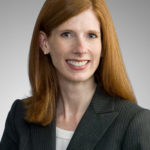
"Her first year as an environmental program officer at the Houston Endowment was spent in the field with nonprofit leaders, public officials, and community members learning about the issues and the barriers to making change, as well as the players who might be positioned to move the needle, she said. It was a steep learning curve," according to a story about the report in The Chronicle of Philanthropy.
"What the grantee brings is knowledge, expertise, boots on the ground that can help advance those goals," Love told The Chronicle. "I always try to acknowledge our respective roles and emphasize that we as the funder don’t have deep subject expertise that the grantee does."
The other program officers featured in the report:
- Jamie Allison of the S.H. Cowell Foundation
- Caroline Altman Smith of the Kresge Foundation
- Irfan Hasan of the New York Community Trust
- Jackie Hausman of the Kenneth Rainin Foundation
- Sarah Lovan of the McKnight Foundation
- Emiko Ono of the William and Flora Hewlett Foundation
- Stacy Parker-Fisher of the Oak Foundation
- Nicholas Randell of the Peter and Elizabeth C. Tower Foundation
- Teresa Rivero of the Bill & Melinda Gates Foundation
- Graciela Selaimen of the Ford Foundation
To our funders, with thanks and gratitude
Dear funders,
 While we feel this way all year at TFN, in the spirit of Thanksgiving I want to take a moment to express gratitude for our network of funders and partners dedicated to unraveling society’s most difficult problems, be it environmental injustice, irresponsible growth or inequitable policies, and whose work may often feel thankless. Now more than ever, we see that philanthropy can be relied upon to bring together the right people, ideas and resources to find solutions to those problems.
While we feel this way all year at TFN, in the spirit of Thanksgiving I want to take a moment to express gratitude for our network of funders and partners dedicated to unraveling society’s most difficult problems, be it environmental injustice, irresponsible growth or inequitable policies, and whose work may often feel thankless. Now more than ever, we see that philanthropy can be relied upon to bring together the right people, ideas and resources to find solutions to those problems.
I’m also exceedingly grateful to the TFN team — our community of staff, contractors, and board of directors — who work so diligently to ensure that our network continues to thrive and grow.
Especially in a year where it seems every news cycle brings a story of unimaginable loss or a startling reminder of the deep-seated divisions we face as a country, it is heartening to be surrounded by people who are dedicated to supporting the important work of building communities that are more equitable, sustainable and resilient. Not just for some but for all.
We thank you for the work you do today — and every day.
What are we learning about in December?
What are we learning about in December?
We have two upcoming webinars that may be of interest to our funders:
Impact Investing Where It Matters Most
10 a.m. PT, Dec. 5
Join Smart Growth California for a funders-only video conference on the challenges and opportunities for impact investing in low-income communities and other communities in which it is typically harder to deploy capital. You'll hear from The Kresge Foundation about their work investing in climate resilience and water as well as The California Endowment about the upcoming launch of the Freshworks 2.0, a program-related investment for healthy food access. Register here.
Speakers include:
- Judi Larsen and Amy Chung, The California Endowment
- Cat Howard, Northern California Community Loan Fund
- Jalonne White-Newsome, The Kresge Foundation (and a 2017 TFN PLACES Fellow)
- Moderator: Katherine Pease, Director of Impact Investing, Cornerstone Capital Group
Greenspace Conservation in Metropolitan America: Partnerships That Benefit People and Nature
3 p.m. ET Dec. 12.
Join TFN's monthly Learning Network Webinar to learn more about the promise of landscape conservation within metropolitan areas, the Metropolitan Greenspace Alliance's national efforts, and the role of funders in this movement. This webinar is organized by TFN's Intermountain West Funder Network. Register here.
The conversation will include:
- Deborah January-Bevers, President and CEO of Houston Wilderness
- Michael Wetter, Executive Director of Intertwine Alliance
- Claire Robinson, Founder and Managing Director of Amigos de los Rios
- Peter Pollock, Manager of Western Programs at Lincoln Institute of Land Policy, who will moderate the call.
Partners for Places: "Can technology create inclusive cities?"
At the heart of any sustainability effort is hope for the future: That the right combination of people, resources and ideas will result in communities that are healthier, safer and stronger for generations to come.
So what role does technology have in these communities of the future?
Rob Phocas, energy and sustainability manager for the City of Charlotte, N.C., explores this topic in a recent contribution to CIO Review's "Smart City" special edition. Charlotte was one of seven cities to receive a matching grant through the Partners for Places Equity Pilot Initiative earlier this year. The equity pilot initiative supports cities and their place-based foundation partners to develop local approaches for prioritizing equity in sustainability and/or climate action. (This two-year pilot program is supported by the generosity of The Kendeda Fund and The Kresge Foundation.)"
"I like the latest 'smart' technology as much as the next person. Be it a smart streetlight, a digital kiosk, or a solar powered bench that charges your smart device and counts passers-by, it is hard not to find futuristic features appealing. But as a sustainability director and public servant, I must look past that cool factor," writes Phocas. "At a recent smart cities conference at the University of North Carolina at Chapel Hill, the conference organizers asked the presenters to answer a question during their remarks: 'Can innovative smart city technology create coherent and inclusive cities?'”
His answer:
"What started as an industry-lead effort focused on promoting the latest gadgets to municipalities is shifting to a municipal-lead effort to understand which of these gadgets can help staff achieve their mayor and/or city council’s goals of creating a great quality of life for their residents. Charlotte’s approach is no different, which is why my answer to the question about technology creating coherent and inclusive cities was, 'No.' It is people, after understanding the unique needs of their residents, who will use these innovative smart technologies to create coherent and inclusive cities, not technology alone."
Read Phocas' take on smart city technologies, and learn more about how Charlotte is working to plan for its future by focusing on meaningful community engagement, in the the full story.
TFN Learning Network Call | Greenspace Conservation in Metropolitan America
Don't forget to register for this month's TFN Learning Network Call!
Greenspace Conservation in Metropolitan America: Partnerships That Benefit People and Nature
Wednesday, December 13, 2017
3:00 – 4:00 p.m. ET
| Across metropolitan America, conservation coalitions are working in urban areas to achieve ecological, social, and economic outcomes. These partnerships navigate both the complex ecosystem challenges, as well as complex organizational environments of metropolitan regions. They work across multiple jurisdictions and issue areas, and use resources from the public, private, non-profit, and academic sectors.
In 2009, Houston Wilderness hosted an inaugural meeting of what would become the Metropolitan Greenspace Alliance (MGA). Today MGA is a national network of networks connecting the urban environment to the natural environment for the benefit of the people and nature within urban areas. Join TFN’s December 13th webinar to learn more about the promise of landscape conservation within metropolitan areas, MGA’s national efforts, and the role of funders in this movement. MGA coalitions impact many critical issues facing urban areas today: The conversation will include Deborah January-Bevers, President and CEO of Houston Wilderness, Michael Wetter, Executive Director of Intertwine Alliance, Claire Robinson, Founder and Managing Director of Amigos de los Rios and Peter Pollock, Manager of Western Programs at Lincoln Institute of Land Policy, who will moderate the call. Please register for this funder-only webinar by Friday, December 8, 2017 to be sure that you receive log-in details. |
From our members: Pisces Foundation's David Beckman on tackling water resource challenges
Water affects every aspect of our lives, both as individuals and as communities.
"Despite water’s importance to each and all of us, as a society we have not invested in the solutions that will enable us as a nation to keep up with the challenges water resources face today—population growth, aging infrastructure, loss of natural vegetation, pollution from farm fields and from cities, all made more challenging by climate change," writes David Beckman, president of the Pisces Foundation, a TFN member. "That is why when we started the Pisces Foundation, the question we wrestled with was not whether to make water one of our focus areas. Rather, the question was: given its importance and complexity, how do we best tackle it?"
Beckman explores the answer to this question in a recent Pisces Foundation blog post, Water: A Key to Our Collective Future.
Be sure to read the full post, and feel free to leave your own ideas on tackling the tricky issue of water resource challenges in the comments section below.
Meet our newest Partners for Places grantees!
We're proud to announce the latest recipients of our Partners for Places matching grants!
Eleven cities across the United States will receive nearly a million dollars for sustainability efforts that largely benefit low-income neighborhoods. That means 11 cities, 11 sustainable solutions.
These sustainability efforts will take place in cities both large and small, from a project in Los Angeles that tackles park scarcity in the city’s most densely populated areas to an agricultural program in Cary, N.C., that supports women and minority farmers while giving low-income residents greater access to healthy food.
The funding is through the Partners for Places matching grants program, which pairs city governments with philanthropy to support sustainability projects that promote a healthy environment, a strong economy, and well-being for all residents.

Three of the grantees — Bend, Ore., Lancaster, Pa., and New Orleans — will use the Partners for Places matching grants to help craft a climate action plan, a blueprint that describes the policies and measures that cities will enact to reduce greenhouse gas emissions and increase their community's resilience to climate change.
“I think we have a commitment to future generations to take steps to make sure at a minimum we leave this planet in the same shape we found it,” said Lancaster Mayor Rick Gray in a video explaining the city’s efforts to address climate issues — and plan for its future. “There’s no better place to start this type of thing than at the local level.”
Partners for Places, led by the Funders’ Network for Smart Growth and Livable Communities in partnership with the Urban Sustainability Directors Network, will provide $484,000 in funding to 11 cities through its general grant program, which will be matched by local funders. That means a total of $968,000 will be leveraged to fund sustainability projects in these selected cities.
“These projects are about fighting the next climate-related disaster," said Darryl Young, director of Sustainable Cities at The Summit Foundation. "Flood, fire, devastation. It's easy to feel overwhelmed, but it’s important — especially at the city level — to think proactively, to learn how to adapt, to prevent and respond in order to avoid becoming a cautionary tale.”
The program is supported by five investor foundations: The JPB Foundation, The Kendeda Fund, The New York Community Trust, The Summit Foundation, and Surdna Foundation. This grant cycle also includes $127,500 awarded to three green stormwater infrastructure projects, designed to advance water-related sustainability goals, made possible by the support of the Pisces Foundation, the Fred A. and Barbara M. Erb Family Foundation, and the Turner Foundation.
“These types of projects can help cities accomplish so much,” said Nancy Stoner, Water Program director and a senior fellow at the Pisces Foundation. “They not only improve water quality and water supply, but also beautify neighborhoods, create jobs, and help communities become healthier and more climate resilient.”
To date, Partners for Places has awarded $5.4 million across North America in this successful matching grant program, leading to nearly $11 million in philanthropic investments. Partners for Places will open a new round of funding for the general grant program in December.
The latest Partners for Places grant recipients and their matching funders are:
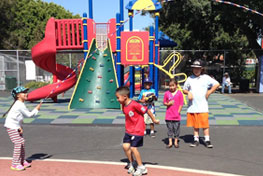
- Bend, Ore($50,000): To engage diverse voices to create a community climate action plan with innovative strategies that balance equity, efficiency and meaningful climate benefits. (Matching funder: Oregon Community Foundation Advised Funds)
- Cary, N.C.($25,000): To support equitable access to farmland for minority and women farmers and access to food for low-income residents through SNAP EBT, and a double bucks program. (Matching funder: Triangle Community Foundation)
- Cincinnati, Ohio($115,000): To enhance sustainability of Cincinnati’s regional food system through strategic, collaborative activities to prevent, recover, and recycle food waste and educate the public on the issue. (Matching funders: The Greater Cincinnati Foundation, Carol Ann & Ralph V. Haile, Jr./U.S. Bank Foundation, Interact for Health)
- Lancaster, Pa.($30,000): To support an equity-focused, community-wide planning effort resulting in a comprehensive climate action and resilience plan for the City of Lancaster and an initial implementation project. (Matching funders: Lancaster County Community Foundation, The Steinman Foundation)
- Los Angeles, Calif.($35,000): To tackle park-scarcity in LA’s densest and lowest-income regions by opening vibrant school playgrounds to the public through its Community School Parks program and empowering low-income residents through enhanced community engagement. (Matching funder: First 5 LA and The Goldhirsh Foundation)
- New Orleans, La.($45,000): To engage the community in making equity a priority in implementation of the City of New Orleans’ Climate Action Strategy and to help the city meet the strategy’s climate mitigation goals equitably. (Matching funder: Greater New Orleans Foundation)
- Philadelphia, Pa.($25,000): A data-driven approach to identify Philadelphia populations disproportionately exposed to environmental stressors, and reduce disparities through community-centered decision-making. (Matching funder: Knight Foundation)
- Salt Lake City, Utah($31,500): To empower Salt Lake City’s low-income and communities of color to engage in efforts to mitigate climate change impacts, improve community resiliency, and ensure social equity. This will be achieved through engagement in the Utah Climate Action Network, coupled with a community-driven energy efficiency campaign. (Matching funders: The George S. and Dolores Doré Eccles Foundation, The Community Foundation of Utah, Richard K. and Shirley S. Hemingway Foundation, Telemachus Foundation)
This round of Partners for Places matching grants also recognizes three green stormwater infrastructure projects:
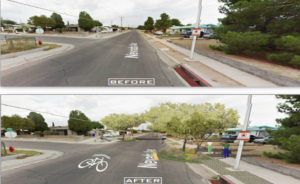
- Grand Rapids, Mich.($51,250): To prepare and implement a plan to fund and install green infrastructure and water conservation practices in low income-neighborhoods. (Matching funder: Wege Foundation)
- Las Cruces, N.M.($25,000): To build community resilience and cohesion in a low- to moderate income urban neighborhood as part of a project to design and construct a green infrastructure corridor and engage in community-building activities, combating extreme heat and drought. (Matching funder: Santa Fe Community Foundation)
- St. Louis, Mo.($51,250): Will plant trees to manage stormwater, enhance tree canopy, reduce heat island impact, and strengthen community relations by holding community tree-planting events with off-duty police officers and providing summer youth jobs for tree stewardship. (Matching funders: St. Louis Community Foundation, W.A. Kerr Foundation, Commerce Bancshares Foundation)
About Partners for Places Partners for Places
A joint project of the Funders’ Network for Smart Growth and Livable Communities and the Urban Sustainability Directors Network, Partners for Places is a successful matching grant program that improves U.S. and Canadian communities by building partnerships between local government sustainability leaders and place-based foundations. National funders invest in local projects developed through these partnerships to promote a healthy environment, a strong economy and well-being for all residents. Through these investments, Partners for Places fosters long-term relationships that make our communities more prosperous, livable and vibrant.
For additional information and media inquiries, contact: Tere Figueras Negrete, Communications Director at the Funders’ Network for Smart Growth and Livable Communities, tere@www.fundersnetwork.org
Funders interested in becoming a part of Partners for Places should contact Director of Programs Ann Wallace.
Interested in Green Infrastructure? Join our Stormwater Funders' webinars!
Over the last several months, members of the Stormwater Funders’ Group have had a series of conversations about the multiple benefits of green infrastructure, such as public health and community investment, in addition to their largely known water quality benefits.
In recent months, funders have expressed interest in better studies to quantify multiple benefits, communicating the benefits more clearly for skeptics and decision makers, particularly local governments and smaller utilities, and integrating multiple benefits outcomes into green infrastructure projects.
And we are listening!
During this webinar, we hope funders will learn about how green infrastructure practitioners are thinking about multiple benefits, how various multiple benefit valuation tools and about the latest research on multiple benefits by the universities participating in the Urban Water Innovation Network. There will also be time for funder-only discussion following the presentations to explore funder interests and opportunities to work together.
Our speakers include Paula Conolly of Green Infrastructure Leadership Exchange, Heather Cooley of Pacific Institute, Neil Grigg, Ph.D of Colorado State University and the Urban Water Innovation Network and Nancy Stoner of Pisces Foundation as our moderator.
This funder-only webinar will be on Tuesday, November 7 at 1:00 p.m. ET/ 10:00 a.m. PT. Registration for this event ends on Friday, November 3.
To register, click here.
Wait! Want more Stormwater Funders’ Group learning opportunities?
Stormwater Funders’ Group is also organizing this month’s TFN Learning Network Call! This month’s call, Green Streets: Re-envisioning Water and Transportation Infrastructure, which will focus on the benefits of integrating water and transportation infrastructure.
This funder-only webinar will be on Wednesday, November 8t at 2:00 – 2:00 p.m. ET/ 11:00 a.m. PT. Registration for this even will end on Friday, November 3.
To register, click here.
Additional resources:
- ICYMI: In a recent editorial for the Detroit Free Press, John M. Erb, president and chairman of the Fred A. and Barbara M. Erb Family Foundation, shares the many benefits of green stormwater infrastructure, noting that Detroit is well situated to take the lead on implementing sustainable innovation: "With land abutting our lakes and rivers and more than 600,000 creative and resilient residents, Detroit has an unprecedented opportunity to become a leader in demonstrating the role green stormwater infrastructure can play in creating a healthier more prosperous city." Read the full piece here.
- Check out this video from Urban Water Innovation Network (UWIN), a consortium of academic institutions and key partners across the U.S.


